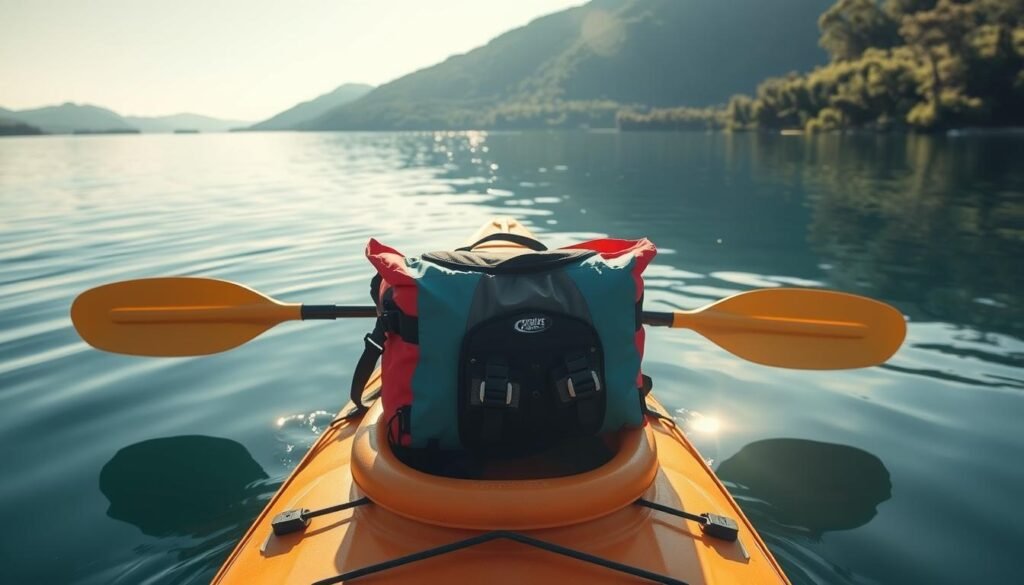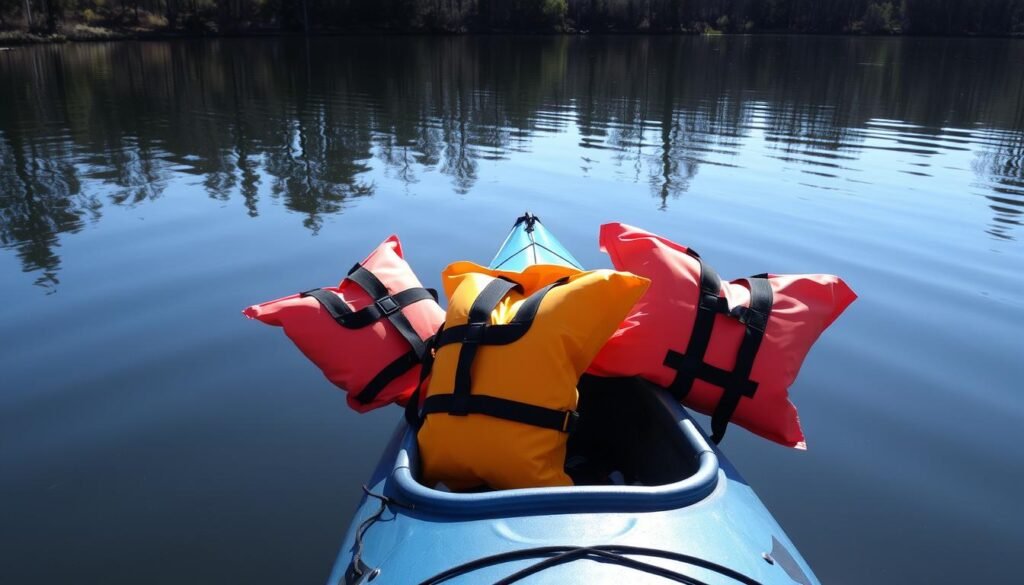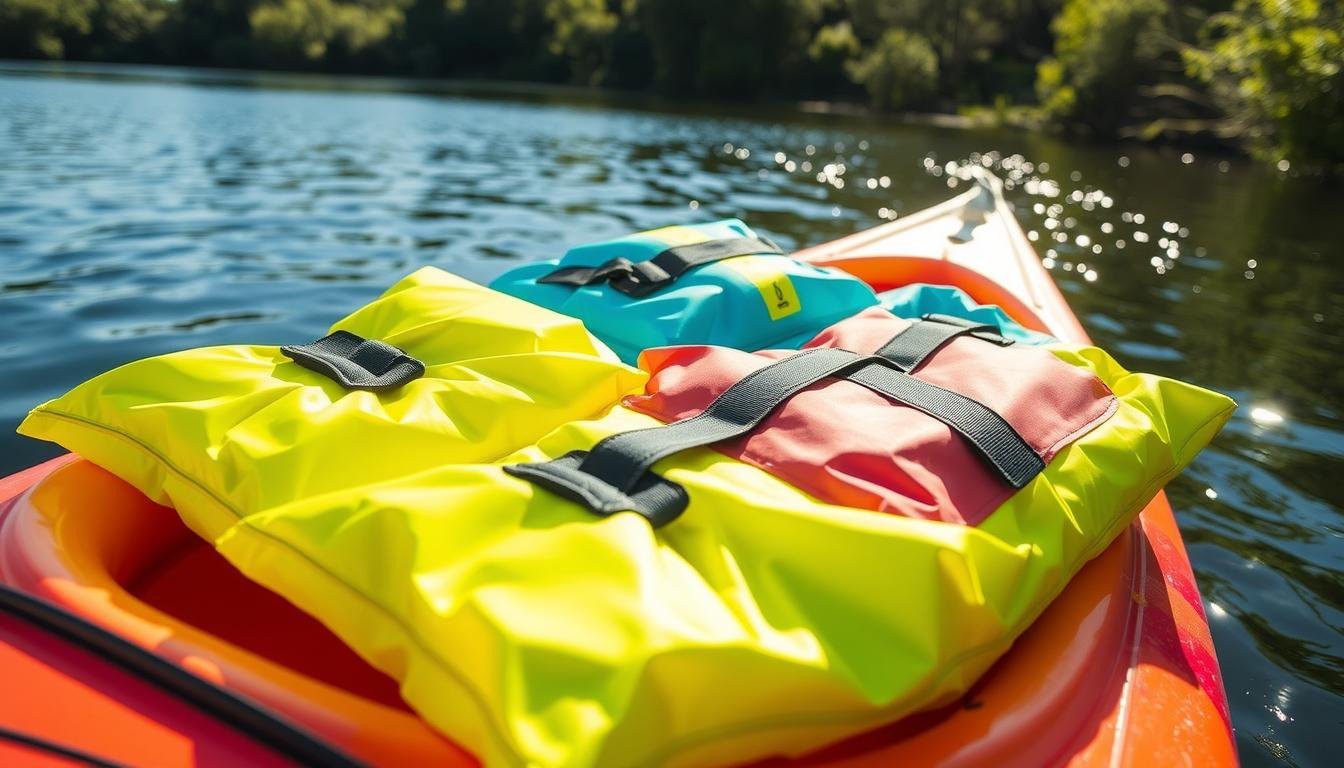I love kayaking and have always wondered about float bags. These inflatable devices promise to keep us safe if we flip. But do float bags work in kayaks? Let’s explore whether float bags are worth it for all kayakers and if they truly enhance safety on the water.
Key Takeaways
- Float bags can make a kayak more buoyant and stable, helping in emergencies.
- Kayaks with watertight bulkheads might float better than those with just float bags.
- It’s key to install and maintain float bags right for them to work in an emergency.
- There are many float bag styles and sizes for different kayaks and places to paddle.
- Using float bags with other safety gear can make kayakers even more ready.
Table of Contents
Introduction to Float Bags in Kayaks
Kayaking is fun and rewarding, but it has risks. Using kayak flotation, like float bags, is key for safety. These devices help keep the kayak afloat and let paddlers self-rescue if they capsize.
Understanding the Role of Flotation in Kayaking Safety
Flotation is vital for kayaking safety. It decides if a kayak stays afloat and if the paddler can safely get back in or to shore in an emergency. Kayak flotation is even more crucial in cold water. It can save lives by helping paddlers quickly self-rescue.
“Proper flotation is essential for kayaking safety, enabling paddlers to confidently navigate the waters and respond effectively to any unexpected situations.”
Knowing about kayak safety and float bags helps kayakers have a better time on the water.
What Are Float Bags?
Float bags are key for kayakers. They add buoyancy and stability when a kayak takes on water. These inflatable bags fit inside the kayak’s bow and stern, ready to help when needed.
The main job of float bags is to keep a kayak afloat. They push water out of the kayak’s compartments. This lets the paddler safely get back in or swim to shore, avoiding danger.
Float bags come in many sizes for different kayaks. In whitewater kayaks, they’re long and triangular. Most boats over 8 feet use them in the bow too.
Some makers have added dry bags to float bags. This makes a bag that keeps gear dry and provides floatation. It’s a smart move for kayakers.
Float bags are vital for safety, whether in rapids or on the sea. They ensure a safe trip. Knowing their importance makes kayaking more enjoyable and secure.
| Product | Description | Price |
|---|---|---|
| NRS Kayak Float Bags | High-quality inflatable float bags for kayaks, designed to provide essential buoyancy and stability. | $49.95 – $99.95 |
| Salamander Canoe Airbags | Versatile flotation devices for canoes and kayaks, available in various sizes to fit different boat types. | $59.99 – $89.99 |
| Harmony Gear Kayak Float Bags | Durable and easy-to-use float bags that help keep kayaks afloat in the event of a water breach. | $39.95 – $69.95 |
Adding float bags to your kayaking gear makes trips safer. It gives paddlers confidence, knowing they have a backup plan.
Types of Float Bags
Kayakers have two main float bag types: bow and stern, and hull float bags. Each type has its own purpose. They help make kayaking safer and more stable.
Bow and Stern Float Bags
Bow and stern float bags add buoyancy at the kayak’s front and back. They keep the kayak upright in rough waters. Bow and stern float bags are great for whitewater kayaking. They help the kayak stay stable and easy to handle.
Hull Float Bags
Hull float bags run along the kayak’s sides. They add buoyancy all over the kayak. Hull float bags are good for sea kayaking and long trips. They offer extra storage and keep the kayak stable, even with lots of gear.
Float bags are key for kayak safety. Knowing the difference between them helps you choose the right ones. This ensures a safer and more fun kayaking experience.
“Watershed stow float bags are loved, with two Futa Stowfloats carried in the stern and one Salmon Stowfloat in the bow of a Dagger Katana 10.7 for a 3-4 day self-support float.”
do float bags work in kayaks
Yes. Kayaking fans often wonder if float bags really help. These inflatable bags are key for keeping kayaks afloat and safe. Let’s see how they work and why they matter for kayaking.
Before the 90s, many kayaks didn’t float well when turned over. Now, most kayaks float a bit, but still get waterlogged. This means the cockpit can fill with water, making it hard to paddle.
When a kayak is full of water, it’s very heavy. This makes it hard to move or pull it out of the water. Float bags help by letting less water in. This makes the kayak easier to handle and safer to paddle.
| Metric | Impact of Float Bags |
|---|---|
| Kayak Weight | Reduces the weight of a swamped kayak by displacing water |
| Kayak Stability | Helps maintain the kayak’s buoyancy and stability when capsized |
| Self-Rescue | Enables easier re-entry and self-rescue in the event of a capsize |
Float bags are a big plus for kayaking safety and fun. They keep the kayak from getting too heavy with water. This makes it easier to get back on and stay safe. If you want a better kayaking experience, try using float bags.

Factors Affecting Float Bag Performance
Kayak Design and Construction
The way float bags work in kayaks depends a lot on the kayak’s design and build. Things like bulkheads, hatch openings, and the shape and materials of the hull matter a lot. They all play a part in how well float bags keep the kayak afloat.
Kayaks with sealed bulkheads work better with float bags than those without. Sealed bulkheads help fill compartments with float bags, making the kayak more buoyant. But, kayaks with open cockpits can be harder to fit with float bags and keep them in place.
The shape and materials of the kayak’s hull also matter. Hulls that are rounded or streamlined fit float bags better. Rigid hulls, like those made of polyethylene or fiberglass, are more stable for attaching float bags. But, soft, flexible hulls can be tricky to secure float bags on.
| Kayak Design Element | Impact on Float Bag Performance |
|---|---|
| Bulkheads | Sealed bulkheads create isolated compartments for effective float bag placement and operation |
| Hatch Openings | Large hatch openings can compromise the ability to properly secure float bags |
| Hull Shape | Rounded, streamlined hulls better accommodate the contoured shape of float bags |
| Hull Materials | Rigid hulls made of polyethylene or fiberglass provide a more stable platform for float bag attachment |
To get the most out of float bags, it’s key to know how your kayak is made. Think about the design and build when choosing and setting up float bags. This ensures you stay safe and afloat.
Installing and Securing Float Bags
It’s important to install and secure float bags right. This ensures they work well in an emergency. Follow these steps to set up your kayak’s float bags correctly.
Float Bag Placement
First, pick the best spot for your float bags. You’ll usually put one in the bow and one in the stern. This keeps your kayak stable and prevents it from flipping.
- Measure the space in the bow and stern to make sure the bags fit.
- Choose a float bag that matches your kayak’s size and shape.
- Make sure the bags won’t block your kayak’s hatches or rudder.
Securing the Float Bags
After finding the right spot, secure the float bags. It’s key to keep them in place while you’re out.
- Adhesive Mounts: Some use adhesive mounts to hold the bags. But, this method might not last long.
- Epoxy Bonding: You can also use epoxy to bond the bags to your kayak. This needs some prep work, like sanding and heating the surface.
- Mechanical Attachments: Another way is to use straps and d-rings. This method is strong and reliable, especially with epoxy.
Test your float bag setup before you go kayaking. Also, check them often to keep your kayak safe.

Float Bag Maintenance and Care
Keeping your kayak’s float bags in good shape is key. Regular checks, cleanings, and storage help them last longer. This means they’ll be ready for you when you need them.
Inspecting Float Bags
Check your float bags often for wear, damage, or decay. Look for cracks, holes, or if they feel brittle. Make sure the valves work right and don’t leak. Fix any problems fast to keep your bags safe.
Cleaning and Storing Float Bags
- Wash your float bags with fresh water after each use to get rid of dirt and salt.
- Let them dry fully before storing them in a cool, dry spot, out of the sun.
- Don’t store them in damp or humid places to avoid mold and mildew.
- For long storage, fold them loosely to avoid creases or damage.
Repairing Float Bags
If your float bags have leaks or tears, you can fix them. Use a repair kit for inflatable items to patch small holes. For bigger problems, you might need to replace parts. Always check the maker’s advice for the best fix.
| Repair Tip | Description |
|---|---|
| G/flex 655 Thickened Epoxy | Great for fixing float bags with tube or valve problems. |
| Waterbed Repair Kits | Good for sealing leaks in different materials. |
By following these float bag maintenance and care tips, you can extend the lifespan of your inflatable float bag. This ensures it’s always ready for your kayaking trips, keeping you safe and supported.
Alternative Flotation Options
Float bags are common for kayak flotation. But, there are other ways to make a kayak more buoyant and stable. These options help ensure safety and fun on the water.
Rigid Foam Blocks
Rigid foam blocks are a good alternative to float bags. They are sturdy and light, fitting in the kayak’s bow and stern. They add extra flotation if the kayak tips over. Foam blocks are durable and easy to put in, making them a smart choice for many.
Inflatable Collars
Inflatable collars are a new way to add flotation. They wrap around the kayak’s cockpit, keeping it upright. They’re quick to use in emergencies and are a good backup to float bags.
Kayak Stabilizers
Kayak stabilizers, like outriggers or pontoons, boost a kayak’s stability. They attach to the kayak’s sides, helping it stay steady in rough waters. They’re great for doing wet exits and getting back in.
| Flotation Option | Key Benefits | Considerations |
|---|---|---|
| Rigid Foam Blocks | – Durable and long-lasting – Easy to install – Provide supplemental flotation | – May take up valuable storage space – Can affect the kayak’s handling characteristics |
| Inflatable Collars | – Quickly deployable in emergencies – Offer reliable backup to float bags – Help keep the kayak upright | – Require regular maintenance and inflation – May add weight and complexity to the kayak |
| Kayak Stabilizers | – Enhance stability in rough waters – Improve performance during wet exits and re-entries – Provide additional buoyancy | – Can be bulky and affect the kayak’s maneuverability – May require specialized mounting and installation |
These options give kayakers many choices for their needs. Exploring these alternatives helps find the best way to stay safe and have fun on the water.

“The right flotation solution can be a game-changer in kayaking safety and performance. It’s important to explore all the options to find what works best for your individual needs.”
Safety Considerations with Float Bags
Float bags are key to keeping you safe while kayaking. But, it’s vital to know their limits and how they fit into a bigger safety plan.
Wearing the right clothes is crucial, even with float bags. You might still get wet, so a drysuit or wetsuit is a must. Also, getting back into a kayak can be hard, and float bags might not help much.
Float bags are just part of a bigger safety plan. With the right gear, skills, and self-rescue knowledge, they can boost your survival chances. Make sure to practice using them before you go kayaking.
Importance of Proper Gear and Training
- Dress for immersion to protect against cold water exposure
- Practice self-rescue techniques, including re-entering a swamped kayak
- Seek proper kayaking instruction and training, including a Swift Water Rescue course
| Kayak Model | Weight | Flotation Performance |
|---|---|---|
| Oru Inlet | 20 lbs | Increased buoyancy with float bags |
| Eddyline Sky10 | 32 lbs | Minimal water intake, maintained stability after capsizing |
Having the right safety gear and training is crucial for kayaking. Float bags are helpful, but not a substitute for being prepared. With float bags, the right gear, skills, and knowledge, you can stay safe and increase your chances of a successful rescue.
Conclusion
Float bags are key for kayaker safety. They offer vital flotation that can save lives. Knowing how they work and keeping them in good shape is crucial.
They help keep a kayak afloat, even when it tips over. This is vital for staying safe on the water. By using float bags and other safety gear, kayakers can feel safer.
Float bags are part of a bigger safety plan. Wearing a PFD and dressing right for the water are also important. These steps help kayakers stay safe and enjoy their time on the water.





